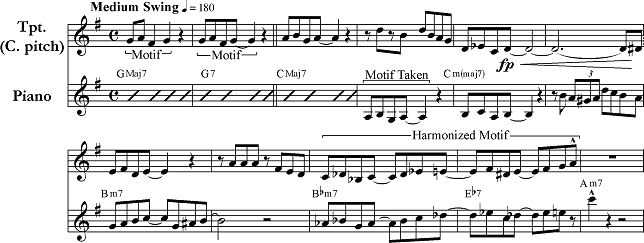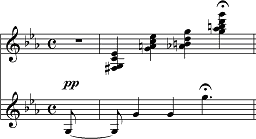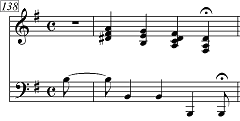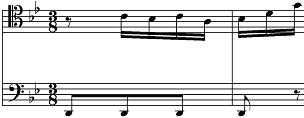Throughout the history of jazz several styles were born, all with one element in common: musicians’ interaction. This interplay has developed in different degrees and within several sub-styles, making collective improvisation the common thread of all jazz categories. Yet the term collective improvisation has been coined to refer to early jazz, as this style of music relies on an obvious collaboration between melodic instruments, primarily trumpet, clarinet, and trombone. Unfortunately though, this designation hinders the appreciation of collective improvisation as a form of artistic relatedness, which has appeared throughout jazz history in different degrees regardless of time period or style. Stephen Nachmanovitch explains this phenomenon of artistic interaction between two given persons in his 1990 book Free Play:
The [collective] work comes from neither one artist nor the other… There is a third totally new style that pulls on us. It is as though we have become a group or organism that has its own nature and its own way of being, from a unique and unpredictable place which is the group personality or group brain (94-5).
Additionally, the author identifies collective rhythm as the basic foundation for musical interaction, referring to it as entrainment:
There is a phenomenon called entrainment, which is the synchronization of two or more rhythmic systems into a single pulse. If a group of men is hammering on a building site, after a few minutes they fall into the same rhythm without any explicit communication. In the same way, the body’s physiological rhythms resonate with each other… When improvisers play together they can rely on this natural phenomenon to mesh the music so that they breathe together, pulse together, think together (99-100).
Thus the sole instance of playing in a group can be called collective improvisation, even if the material is completely prearranged, as in a symphonic orchestra, because the collective vibrating pulse is constructed in the moment, and musicians acquaint each other with their pulses as they get to know each other in performance and rehearsal. Yet, all jazz styles go beyond this basic concept of collective improvisation: several jazz sub-categories evidence an overlap between instruments’ roles, as well as musicians’ interaction in the development of motifs, structure, texture, and tempo. These forms of interplay constitute a step further from simply synchronizing pulses, and they are observable not only in early jazz. In this way, jazz music can be identified as having greater and lesser degrees of collective improvisation, regardless of time period or stylistic characteristics.
The lowest degree of collective improvisation in jazz appears in big bands, the closest group configuration to a symphonic orchestra, as the arrangement presets the direction of music. Occasional soloists function as transitions between moods within the piece, so the main form of group improvisation, still existent in this setting, is the collective pulse. Nonetheless, there are exceptions to these restrictions, such as Paul Gonsalves’s solo in “Diminuendo and Crescendo in Blue” with Duke Ellington’s band in the 1956 Newport Jazz Festival. Gonsalves takes his time to develop his ideas, and his individual improvisation becomes an independently spontaneous excerpt from the arrangement. Additionally, between 9:26 and 9:40 there is an overt interaction between him an Ellington, as the pianist begins a rhythmic figure that inspires the soloist to shape his lines around it, creating an unpremeditated call-and-response effect. This exception shows how collective improvisation can go beyond a collective pulse, even within the context of a big band, where most of the music is prearranged.
Bebop shows a similarly low degree of collective improvisation, as the demanding task of running chord changes burdens a soloist, and thus solos are usually developed without much space for interaction besides sharing a common pulse. Nevertheless, Charlie Parker, the king of bebop, can show his interactive capabilities more freely in a different setting: ballads. In the famous recording of “Lover Man,” from Charlie Parker on Dial, 1946, Parker interacts with trumpeter Howard McGhee. Although the trumpeter seems indifferent to Parker’s responses during the melody in the outhead, the alto saxophone icon creates counterlines to McGhee’s shaping of the tune. This piece evidences a few more aspects of collective improvisation. First, the greater the demands imposed by music, the lower the possibility of interaction with the surroundings, as exemplified by the contrast between ballads and fast bebop tunes: a ballad offers more chances of interaction than a piece requiring frantic run of the chord changes. Second, it is not possible to classify musicians strictly as collective or individual improvisers, because collective improvisation is a form of artistic relatedness that appears in different degrees according to circumstantial factors, and artists can alternatively find themselves in different situations, playing ballads or bebop tunes, that motivate one or another degree of interaction.
Collective improvisation increases as musicians allow themselves to spontaneously play, as Nachmanovitch calls it, the Twenty Questions game: “Unceasingly, the mind plays the old Twenty Questions game, in which one tries to guess what the other person is thinking of by asking a series of yes-or-no questions” (103). Thus, this procedure allows for innumerable musical conversations. Since a vast part of the jazz repertoire exhibits a medium degree of collective improvisation, where this Twenty Questions game is strongly present but not all aspects of music are improvised, it is possible to describe this level of interaction by selecting music from several different jazz styles. John Coltrane’s recording of “Pursuance,” from A Love Supreme, 1965, shows Elvin Jones’s support of McCoy Tyner’s solo, as he increases or decreases the intensity of his drum accompaniment depending on the pianist’s decisions. Taking into account Nachmanovitch’s concept of group brain, we must understand this process of interaction, not as the musicians’ intellectual understanding and preplanning of reactions to each other’s solo in every potential circumstance, but as the emotional motivation that a soloist inspires in his accompanist, who in turn, triggers a response that contributes to the overall texture of the improvisational process. Based on this phenomenon, from 4:13 Tyner constructs three phrases that repeat the same rhythmic pattern, and Jones responds by accenting the pattern’s main structure in the third phrase, supporting the pianist’s expression by his own expression. Coltrane’s solo follows immediately, and to add support and form to it, Tyner and Jones continue accenting the pattern together in every chorus. This improvised decision gives Coltrane a rhythmic underpinning over which to develop his ideas, and when Coltrane shrieks at 4:49 and 6:40 increasing the intensity, the piano and drums accent the rhythmic hits more strongly as a response to Coltrane’s decision. This development is an illustration of the Twenty Questions game, Nachmanovitch’s explanation of unfolding form.
Yet this set of yes-or-no questions can lead not only to meaningful musical support to the soloist but also to an overlap of the roles between soloist and accompanist. A piece that shows this aspect of a successful musical interaction is Chet Baker’s “Just Friends,” from the 1955 album, Chet Baker Sings with Bud Shank, Russ Freeman, and Strings. At 1:33 Baker starts developing a clear motif that pianist Freeman copies at 1:37. The musicians overlap their roles from then until 1:46, as Freeman begins playing lines and developing the motif in collaboration with Baker. The end of this shared section evolves into a spontaneous harmonization of the developed motif, with one voice for each instrument, piano and trumpet. The interaction between Freeman and Baker is so successful that this spontaneous arrangement seems pre-established, but two clues hint at its creation in the moment: the subtle inaccuracy of the phrase’s conclusion, where the trumpet finishes on the end of beat four and the pianist on beat one, and the musicians audible laughs at that moment, indicating a feeling of surprise in both.
“Just Friends” at 1:33

Another master at collective improvisation is pianist Keith Jarrett. The Imagica Media DVD of his 1996 Japan concert, with Gary Peacock and Jack DeJohnette, shows the artists’ attention at each other’s propositions and their capacity to react quickly. During the four-bar trading in “All the Things You Are” at 1:28:50, the drummer develops a rhythmic motif consisting of a triplet and a quarter note. Jarrett picks up this rhythmic figure in the end of his eight-bar section, and DeJohnette repeats it immediately after Jarrett drops it.
Keith Jarrett Trio Japan Concert at 1:28:50—“All the Things You Are”




This phenomenon where musicians overlap their roles, share a musical figure, and develop it as they pass it around, such as the motif shared by DeJohnette and Jarrett in “All the Things You Are” or the spontaneous arrangement shared by Baker and Russell in “Just Friends,” could be referred to as collective motivic development.
In addition to collective motivic development, the Twenty Questions game can lead to the development of a spontaneous structure, which could be called collective structural development. This phenomenon happens in Keith Jarrett Trio’s performance of “Billie’s Bounce”: the three musicians gradually construct the form in Jarrett’s solo as introduction, development, and conclusion, by balancing the music’s activity, intensity, and direction. At first, Peacock and DeJohnette accompany with low volume, and the drummer engages in a polyrhythmic pattern that gives the tempo a feel of vagueness and uncertainty. This accompaniment fits the beginning of Jarrett’s solo, as the pianist also generates musical uncertainty by avoiding definite lines and playing sporadic chords and notes. This introduction recreating indefiniteness is so successful that Jarrett is moved to restate the head of Billie’s Bounce before moving on to the following stage, in which Peacock increases his volume, DeJohnette plays a straighter swing pattern, and Jarrett develops clearer lines. In this way, the group brain decides when the introduction finishes and the body starts, and thus this interaction shows how it is possible to generate structure spontaneously, giving the piece a form with an introduction and development.
Sonny Rollins’s solo in “Without a Song” from The Bridge, 1962, featuring Jim Hall on guitar, also evidences collective structural improvisation. There is a sense of improvised structure, as bassist Bob Cranshaw does not walk in the beginning but plays half-time feel. This feel matches the saxophonist’s initial indefiniteness in his phrases. After the first chorus, Cranshaw starts walking, and Rollins plays lines with a clearer direction. As it happens in Jarrett’s version of “Billie’s Bounce,” the transition from one texture to the next is made by the group personality, with all musicians generating collective structural development.
As the number of yes-or-no questions increases, other aspects of music can be included in the process of collective improvisation, arriving at a stage that could be considered as having a high degree of interaction. Paul Motian’s trio with Bill Frisell and Joe Lovano focuses on tempo and texture. The melodies are played rubato, with all band members attentive to each other’s decisions and moving forward together. Bill Frisell himself explained the trio’s concept of tempo in a masterclass on April 29, 2006, at the Center for Improvisational Music, New York: “a lot of times its just the melody… we all have the melody sort of going at the same time.” This description shows the trio’s improvisation of tempo in its performances.
Regarding texture, Frisell accompanies with simple chords, sometimes only bass notes, and sometimes arpeggios. He alternates these elements to change texture and tone, also using a distortion pedal and a loop box. The loop effect is a clear example of the trio’s (and Frisell’s) focus on texture, as the main function of the device is not to repeat specifically selected melodies but to generate a supporting background. Additionally, Frisell and Lovano overlap their roles, with the saxophone sometimes fulfilling the role of the absent bass, and their melodies often cannot be identified as constructed with traditional cells, but seem to lack that type of meaning. This characteristic hints at their function of mixing with one another to create a color of either smoothness or noise, depending on the circumstances. A clear example of a noisy texture of this trio occurs in “Cosmology,” from Trioism, 2005, in which Frisell’s distortion, Lovano’s shrieks, and Motian’s percussive attacks on his cymbals and toms converge. Paul Motian’s role, far from timekeeping, is to add ornamental sounds with his brushes and sticks. This characteristic shows another possible situation present in collective improvisation. Since all three instruments are contributing to the same texture and melodic instruments do not stand out for their lines but for their tone, it is possible to affirm that drums, guitar, and saxophone are fully overlapping into the same function, creating a texture, and into the same role, generating colors.
Summarizing collective improvisation concepts as presented thus far, we can establish that this interplay may involve a simple collective pulse, rhythmic support to a soloist, call-and-response, motivic development, structural development, development of texture, and collective tempo. In the process of constructing music, instrumentalists overlap their roles, and the number of instruments mixing up varies. Sometimes the entire band overlaps, and sometimes just a few members. In addition, this overlap can occur both in function, the creation of structure or melodic ideas, and in role, whether the instrument assumes a melodic, supporting, or percussive task. For example, Chet Baker’s recording of “Just Friends” shows an overlap between trumpet and piano only, while drums and bass remain relatively constant. At the same time, piano and trumpet overlap fully in the main role of melodic instruments. On the other hand, in Keith Jarrett’s version of “Billie’s Bounce,” all instruments take part in developing a common structure, but neither does the bass take the role of the piano as melodic instrument nor do the piano and bass assume the role of the drums as percussive instruments. Thus in this case all instruments overlap in function but not in role. In contrast to both Baker and Jarrett’s pieces, in Motian’s trio we see that guitar, saxophone, and drums not only overlap in the function of generating a collective texture but also fully share the same role, as their musical focus is the creation of different colors, whether by means of shrieks, distorted notes, or drum hits.
There is another characteristic of collective improvisation that has only been implied thus far. As the preceding analysis attempts to show, different aspects of music can be collectively improvised, such as motifs, textures, tempi, and so on. These aspects, however, are seldom treated in an isolated manner; rather, most often they are integrated into one sound, which is the resulting music. For instance, Jarrett’s trio cannot deal with the collective structural development of “Billie’s Bounce” without generating varying textures: rhythmic vagueness vis-à-vis a straighter swing pattern and clearer direction.
A clear example of this integration of collectively improvised musical aspects is “Romain,” from Undercurrent, 1962, by Bill Evans and Jim Hall. As David Rosenthal comments on the liner notes, after the piano-solo introduction and first chorus, the trio evolves into “a genuine duet in which one can’t say who’s the soloist and who’s the supporting actor.” Indeed, the two musicians engage in collective motivic development by passing phrases back and forth to each other and transforming them, notably at 1:51 and 2:17, and by engaging in call-and-response, for example at 2:34.
“Romain” at 1:51

“Romain” at 2:17

“Romain” at 2:34

Additionally, this intertwining of motifs constitutes its own texture, which contrasts with the subsequent piano solo, as Hall stops playing to give Evans full exposure. The contrast between both textures is not only that of collective motivic development against solo piano, but also of rhythmic feel and meter changes, as Evans switches from four-four to twelve-eight after hearing the triplets in the end of the preceding section. As the music tension increases, Hall comes back in and relies on other techniques to generate textural effects: first strumming, showing a subtly more aggressive touch accompanying Evans’s graveness, and then a pedal on the open G string clashing against an A flat and A natural. This increase in tension is followed by both musicians’ increase in intensity that gives resolution to the music in the final chords, which at the same time are laid out in rubato tempo. Thus we can perceive a structure made of different textures: one that involves a great degree of motivic development and call-and-response, a piano solo, and a grave section that increases in tension and resolves. Meanwhile, a common pulse that culminates in a collectively directed rubato tempo conducts all these sections.
An alternate take of “Romain” in the same album allows us to infer which musical aspects are improvised and which preexistent. The collective motivic development section is inexistent in the alternate take, so this section is surely improvised. In both tracks, Evans’s solo switches meters and rhythmic feels, but not in the exact same way as in the master take, as in the alternate take he evolves further into medium swing. Hall’s strumming rhythm appears in both tracks, but in the second one he strums more lightly. Finally, although the end of the piece is rubato in both tracks, the tempo remains faster in the master take than in the alternate one. These contrasts suggest that certain aspects of the performance had been arrived at before the recording date, but the difference in the way they unfold, and in their final result, hints at the musicians’ flexibility. This fact is a sign that the established aspects of the performance might have resulted from rehearsal sessions. In this way, Evans and Hall might have arrived at a structure by experiencing one another in the process of collective improvisation, clearing the rough edges of their work by the time of the recording session. Therefore, collective improvisation in Undercurrent involves motivic development, and collective tempo, texture, and structure, all integrated into one main flow of elements fully shared by both musicians.
The foregoing analyses attempt to show several traits of collective improvisation. First, different aspects of music can be collectively improvised: motifs, rhythmic feels, textures, tempi, and structures. Second, these musical aspects are integrated into one broad flow of music. Third, this collaboration causes an overlap between instruments’ tasks in which all or some of the band members may participate. Fourth, this overlap may occur in function and in role, with instruments transcending their traditional characteristics or not. Fifth, musicians may be more or less interactive in different settings, particularly regarding whether they have played together before and how demanding their music material is. Finally, collective improvisation has appeared at different times in jazz, and although its degree and characteristics have varied between period and style, these differences are more attributable to the demands imposed by music and a style’s standard band configuration than to the styles and periods themselves. For example, the relatively low degree of collective improvisation in the swing era and in bebop could be attributable to the big band configuration and the usual approach of running fast chord changes respectively.
Having established these grounds, we are ready to return to the question of early jazz. How much collective improvisation is there in the style commonly known as “collective improvisation”? To answer this question we must consider musicians’ interaction in every aspect of music. Listening to King Oliver’s recording of “Dippermouth Blues” we can notice that the rhythm section, consisting of percussion set and banjo, remains quite constant and unchanged by the activity of the horn lines: the banjo plays one chord on every beat while the woodblocks mark eighth notes and triplets. The common practice of a banjoist was to choose his chords in the moment, but the rest of the band did not affect his decision. The percussion player’s role was similar, as his marking was improvised but unaffected by the band. Thus there is no overlap or interaction between the roles of these two instruments.
When considering the horns, we can perceive that they are all sharing a common role: playing improvised melodies simultaneously. This is indeed the reason why early jazz has been baptized “collective improvisation.” Nevertheless, historian Mark Gridley explains the common practice of this form of performance in his 2009 book Jazz Styles:
Musicians managed to stay out of each others’s [sic] way partly because they tended to fulfill set musical roles similar to those established for their instruments in brass bands. The trumpet often played the melody. The clarinet played busy figures… decorat[ing] the melody played by the trumpet. The trombone would play simpler figures… outlin[ing] the chord notes… fill[ing] in low-pitched harmony notes… [and] creat[ing] motion in a pitch range lower than the clarinet and trumpet.
Based on this explanation we must understand the horns’ roles during the period of early jazz not only as melody improvisers. We must add a more specific concept to this designation that could nowadays make these roles appear sub-roles. It follows from this line of thought that horns in early jazz are not really overlapping but actually have different assignments, and thus the interaction between them is not as high as it initially seems. Furthermore, as explained by Gridley’s quote, these roles arise greatly from the experience of playing in a setting where music had been pre-established, marching bands, and not so much from experiencing the musicality of individual players, as in Undercurrent.
Regarding texture, Gridley explains that “[f]or many listeners, the greatest appeal of early jazz is the activity of several horn lines sounding at the same time without clashing” (61). Thus, it could be argued that the essence of collective improvisation is that of an improvised texture and not of improvised lines. This argument has its merits considering that the lines lose themselves inside a greater fabric. Nevertheless, it has its shortcomings in view that this texture is always constant because of the instruments’ preset roles. Thus, the goal of this kind of improvisation is not to improvise a texture but to generate one that is already known.
Structure in early jazz is also quite predetermined. This is noticeable in the recording of “Dippermouth Blues.” After a four-bar introduction, two choruses of collective improvisation take place, then two choruses of a clarinet solo follow with stop-time accompaniment, which is thus evidently prearranged, and four choruses of collective improvisation continue, leading to the coda. The texture remains constant throughout the piece, except for the stop-time choruses, and thus the only identifiable structural organization in this work is clearly not improvised.
Finally, the tempo remains constant throughout the piece, so in this tune this aspect is not involved in the Twenty Questions game either (and in no other piece within the early jazz style). Still, the tempo, which Nachmanovitch explained as the phenomenon of entrainment, is the common thread of any collective work, acting as the collective pulse.
So we return to our original question, “How much collective improvisation is there in ‘collective improvisation’”? We began our answer by stating how much there is not. Let us now consider what there is. We know that all musicians are improvising and playing together in the same band. Based on Nachmanovitch’s concept of group brain, we can infer that horn players might be feeding of each other, and that each reacts to the others’ phrases, thus altering his own. This form of collective improvisation is analogous to Gonsalves’s solo in “Diminuendo and Crescendo in Blue,” previously analyzed, where Ellington feeds the soloist with a rhythmic figure at 9:26 and 9:40. Therefore, this process is akin to the relationship between soloist and accompanist, except that everyone is simultaneously a soloist and an accompanist, one that relies on lines instead of chords for his comping. The only reservation to this assertion to be kept in mind is, as Gridley has described, that horn players are still restricted by their range and role.
Jazz history exhibits several degrees of collective improvisation, which could be roughly classified into low, medium, and high. Collective improvisation has been present in greater or lesser degrees throughout jazz history, and it takes into account every aspect of music, integrating them into one general flow of interaction. Some of these aspects are motivic development, call-and-response, texture, structure, and tempo. Additionally, the main driving forces in this process of interplay are the human phenomena of group personality and entrainment. Collective improvisation may also involve spontaneous overlapping of all or some of the instruments’ roles in a band, and this overlap might take place in different degrees: instruments might share the same function, for example playing a melody or generating a common texture, and the same role, for example, a saxophone or guitar generating non-melodic tones along with a drum set. Based on all these considerations regarding collective improvisation, we can finally conclude that even though the phrase “collective improvisation” has been coined to refer to early jazz, this subcategory presents a relatively low degree of interaction, as instruments’ roles are pre-established, their roles do not overlap, and too many musical aspects are preset and relatively static, such as texture, structure, and tempo. Nonetheless, we have to acknowledge that early jazz players must have made their lines interactive, because the phenomenon of group personality or group brain, explained by Nachmanovitch, takes place in all settings as the natural activity of a spontaneous mind. This may hold true even though horn’s melodies in early jazz were restricted by role and range. Conversely, collective improvisation in its broader sense has been present throughout the history of jazz in several ways, within several styles, and during several periods, and we can add that it will continue to exist. It will certainly stay alive, as long as artists do not overlook their inherent capacities of being in the moment, reacting, and interacting.
Bibliography
- Gridley, Mark. Jazz Styles. 10th Ed. Upper Saddle River, NJ: Pearson Education, 2009.
- Nachmanovitch, Stephen. Free Play. New York: Putnam, 1990.
- Rosenthal, David. Liner Notes for Bill Evans/Jim Hall: Undercurrent. New York: Blue Note, 1962.
Discography
- Baker, Chet. “Just Friends.” Chet Baker Sings with Bud Shank, Russ Freeman, and Strings. Pacific Jazz, 1955.
- Coltrane, John. “Pursuance.” A Love Supreme. Impulse!, 1965.
- Ellington, Edward. “Diminuendo and Crescendo in Blue.” Ellington at Newport. Sony, 1956.
- Evans, Bill, and Jim Hall. “Romain.” Undercurrent. Blue Note, 1962.
- Motian, Paul. “Cosmology.” Trioism. Winter & Winter, 2005.
- Oliver, Joe. “Dippermouth Blues.” Gennett Records/Fantasy, Inc., 1923
- Parker, Charlie. “Lover Man.” Charlie Parker on Dial Completed. Disc 1. Jazz Classics, 1946.
- Rollins, Sonny. “Without a Song.” The Bridge. RCA, 1962.
Other Sources
- Frisell, Bill. “General Workshop.” Center for Improvisational Music, New York. 29 April 2006.
- Keith Jarrett Trio Concert 1996. Perf. Keith Jarrett, Gary Peacock, Jack DeJohnette. Orchard Hall, Bunkamura, Japan. 30 March 1996.
































